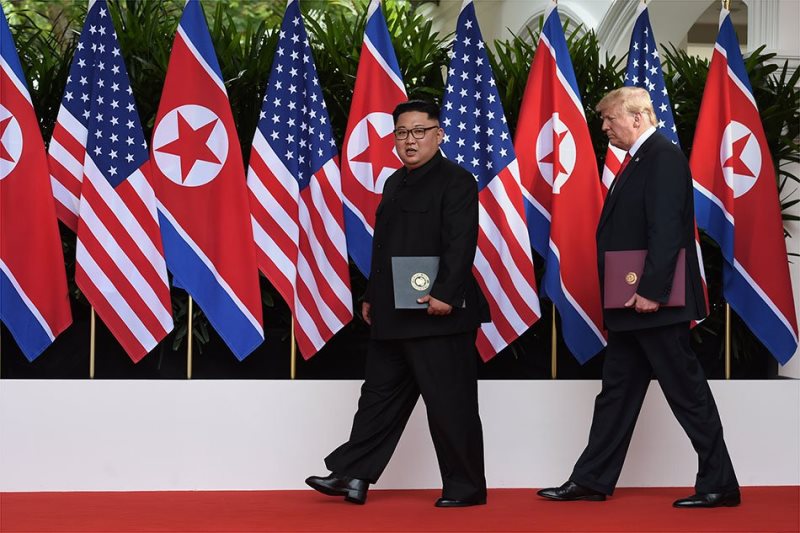With great fanfare, the much-touted Trump-Kim summit took place in Singapore on June 11th. Considered the greatest handshake in history the meeting resulted in a joint statement by US President Donald Trump and North Korean leader Kim Jong Un. Just 4 months ago US president was hurling insults at his counterpart calling him “Little Rocket Man” and a “deranged dotard.” The global media went into overdrive as Trump is the first sitting US president to meet any North Korea dictator. This event is the latest move by the US to regain the initiative on the Korean peninsula, but with many of the thorny details, yet to be worked out, there is plenty of room for the US-North Korea dialogue to break down.
The origins of the tensions go back to the manner in which the victorious allies determined the division of the Korean Peninsula. After Japan’s defeat in World War II, the UN constructed the administration of Korea. The UN divided the peninsula into two zones of administration: the Soviet Union to the North and the US to the South. North Korea refused to participate in a UN supervised election held in the South in 1948, which led to the creation of separate Korean governments for the two occupation zones. Both North and South Korea claimed sovereignty over the Korean Peninsula as a whole, which led to the Korean War.
North Korea invaded the South, using Soviet tanks and weaponry, China also joined the war on the side of Communist North Korea, the threat of communist expansion led to the US defending South Korea and by 1953 the US ended the war in a ceasefire agreement. The two countries never signed a peace treaty. Today the Korean Peninsula remains divided, the Korean Demilitarized Zone acts as the de facto border. With North Korea remaining in poverty and dominated by a ruling family, North Korea thereafter began a uranium enrichment program in order to possess nuclear weapons which have exacerbated tension between South Korea and the North and the US ever since.
The US did not have formal diplomatic relations with North Korea. But despite this the US in 1986 demanded detailed information on North Korea’s nuclear programme, which North Korea refused to hand over to the US, instead it gave those detailed documents running into 19,000 pages to China. An agreement was reached between the US and North Korea in 1994 regarding North Korea’s nuclear reactors. This agreement called for North Korea to bring to halt its nuclear programme and shut down its Yongbyon reactors. This was in exchange for the US supplying two light-water type reactors. But the US failed to honor its part of the promise and hence North Korea resumed its nuclear activities. This has been the case ever since, the US offers a range of promises which do not materialize so North Korea continues with its nuclear programme. For North Korea nuclear weapons is its only bargaining tool.
It has now become a regular occurrence for there to be an incident at least once a year between North Korea and the US, where we see the military movement of both nations; nuclear tests by North Korea and US long range bombers and aircraft carriers moving into the region. The outcome in all these cases is the same, escalation turns into talks which de-escalate matters. This cycle usually repeats itself on an annual basis. When Trump took office like all his predecessors he used plenty of bluster and rhetoric against North Korea, but this time matters were different.
Today the US has exhausted most options in dealing with North Korea, whilst other options are not realistic anymore. One of the options for US is to use its military to conduct surgical strikes on North Korea’s nuclear sites. The problem with such a strategy is that North Korea would be certain to hit back hard, using its own large arsenal of artillery to strike at America’s allies, South Korea and Japan. That would likely kill tens or even hundreds of thousands of people — including the 28,000 US troops stationed in South Korea and thousands of others in Japan — even before nuclear weapons were dropped. So, Trump faced the unenviable reality that using America’s military has huge costs and not just immense consequences but also potentially catastrophic consequences. The other option was to impose economic sanctions on North Korea, so it would conclude that the costs of continuing its nuclear programs were too high. But many items the country wants and needs, like weapons and fuel, are already highly sanctioned by the US. Despite all this, North Korea hasn’t changed its course.
Where Trump changed his posture was when the US was caught off-guard by South Korean President Moon Jae-In’s aggressive normalisation efforts with North Korea. This even led to the North Korean dictator’s sister attending the Winter Games in South Korea as an official guest. This came on the back of Kim Jong Un turning up in China unexpectedly and showed a political process was taking place without the US. It was in this context Trump completely changed his aggressive posture and worked to retake the initiative by agreeing to a summit meeting with Kim Jong-Un.
The summit joint statement talks of lofty issues of denuclearization, establishing new bilateral relations, making a joint effort to establish lasting peace on the Korean Peninsula etc but had no details, framework or timeline.
But the underlying strategic reality remains, America’s engagement with North Korea, as with its aggression in Vietnam 50 years ago, is part of a broader strategy directed against the rise of China. North Korea provides America with the justification to strongly militarise directly on the Chinese border. The crisis also serves to keep the Chinese leadership preoccupied and engaged. It follows that American actions against North Korea form part of a strategy of political manoeuvring in pursuit of a grander aim, China.
Adnan Khan

